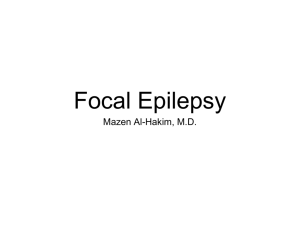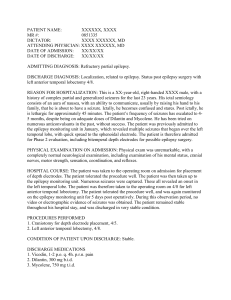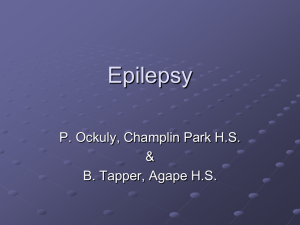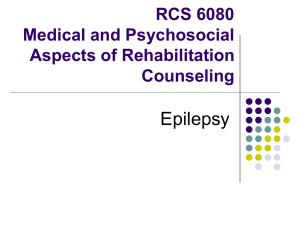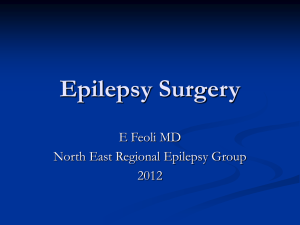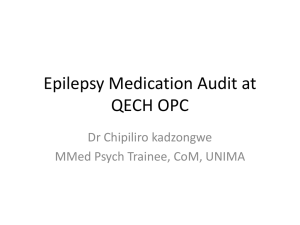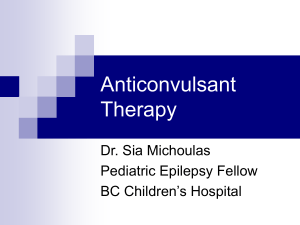Neuropsychology of Epilepsy - Brain & Cognitive Sciences
advertisement
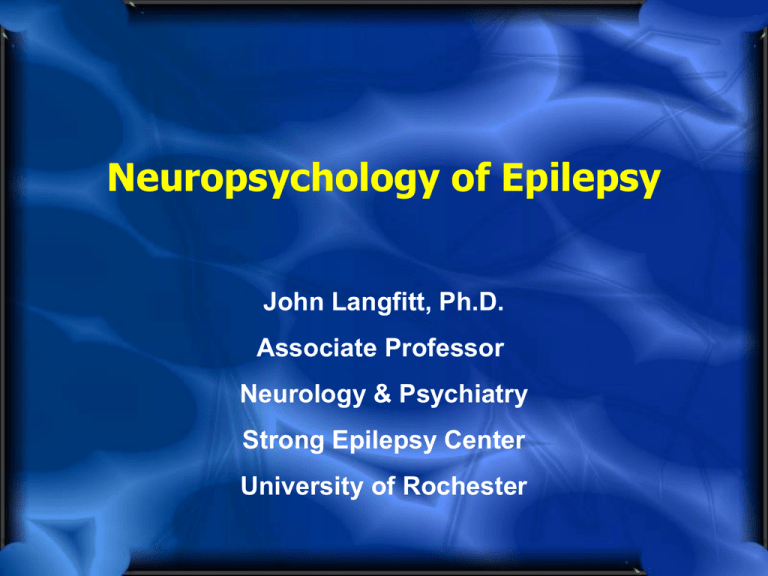
Neuropsychology of Epilepsy John Langfitt, Ph.D. Associate Professor Neurology & Psychiatry Strong Epilepsy Center University of Rochester Overview Definitions & Epidemiology Seizure Types & Cerebral localization Neuropsychological Effects of Medial Temporal Lobe Epilepsy and its Surgical Treatment What is Epilepsy? Seizure – when neural networks fire together in abnormal synchrony Epilepsy – recurrent, unprovoked seizures – does not include single seizures provoked by metabolic disturbance or trauma Normal Neural Activity – low-voltage – mixed frequency – pseudorandom (chaotic?) Seizure – extreme voltage – rhythmic – paroxysmal Propagation of Neuronal Signal PreSynaptic Neuron PostSynaptic Neuron Cell Body Axon Flow of Action Potential Synapse Synaptic Cleft At Rest + + PreSynaptic Neuron - + - + + - - + + + + + - + + + + - + - PostSynaptic Neuron + + Synaptic Cleft Excitatory Post-Synaptic Potential - + + + + - - + - + + + + + + + - + - + + + - + PreSynaptic Neuron PostSynaptic Neuron Bipolar EEG -40 -100 1st 2nd -40 - (-100) = +60 -100 - (-40) = -60 -40 - (-20) = -20 -40 -20 -20 -20 - (-20) = 0 Interictal Discharges Seizure (Ictal) Discharge Frequency of Epilepsy Stroke Epilepsy Parkinson’s Mult. Sclerosis Huntington’s >1/100 6/1000 2/1000 2/10,000 4/1,000,000 Causes of Epilepsy Rochester, Minnesota 1935-1984 Degenerative (4%) Tumors (4%) Infectious (3%) Trauma (6%) Congenital (8%) Vascular (10%) Idiopathic (65 %) Hauser, 1997 Peak Incidence in Childhood and Senescene Prognosis Silanpaa et al., 2000 Living/Marital Situation 200 180 160 p <.0001 140 120 100 80 60 40 20 0 Single Live Alone Dependent Patients (n=240) Divorced Married w/ Children General Population Shackelton, 2003 Employment 120 100 p <.05 80 N 60 40 20 0 Employed Householder Patients (n=243) 'Disabled' General Population Shackelton, 2003 Living Situation/Health by Seizure Control at Follow-up 100 90 80 p =.05 p <.01 p <.01 70 60 % 50 p <.05 40 30 20 10 0 Single/Dependent Gen. Pop. Good Health No Sz, No AED No Sz, AED Co-morbid Illness Sz & AED Shackelton, 2003 Educational/Occupational Status by Age at Onset 70 p <.01 60 50 % p <.05 40 30 20 10 0 Low Educ. Gen. Pop. College Onset > 18 Onset 6-18 'Disabled' Onset < 6 Shackelton, 2003 Percent Never Married Age > 35 (n=161) Onset < 22 Onset >= 22 100 80 3/3 60 40 20 0 Yes No Yes No Special Education Male Female Langfitt & Janzen, 2002 USPop Percent Currently Unemployed (n=237) ‘Grand-mal’ No ‘Grand-mal’ 100 80 60 40 20 0 Yes No Yes No Psychiatric History Low IQ Langfitt & Janzen, 2002 Avg IQ Summary Definitions & Epidemiology – Seizures are rhythmic, paroxysmal neuronal discharges – Epilepsy is defined as 2 or more unprovoked seizures – Epilepsy • • • • • is common in the general population is a symptom, not a disease reflects a broad range of underlying neuropathology can be successfully treated with medicine in most patients and associated problems can lead to activity restrictions and significant psychosocial burden Seizure Types Partial – Simple (no loss of awareness) • sensory • motor – Complex (loss of awareness) • involves spread to both hemispheres T4-T6 C6-T4 T4-S2 S2-S1 Seizure Types Partial – Simple (no loss of awareness) • sensory • motor – Complex (loss of awareness) • involves spread to both hemispheres Generalized– Primary • • • • absence (‘petit mal’) atonic (‘drop’) tonic-clonic (‘grand-mal’) myoclonic (‘jerks’) – Secondary • start as partial, but discharge spreads throughout brain Absence (‘petit mal’) Seizure Seizure Semiology & Cerebral Localization Somato-sensory – tingling/numbness in contralateral extremity Focal motor – hand>face>arm progression (‘jacksonian march’) Visual – flashing lights (calcarine) – formed visual hallucinations (secondary assn. cortex) Auditory – formed auditory hallucinations (secondary assn. cortex) Frontal – often nocturnal – thrashing, vocal outbursts, genital rubbing Limbic – olfactory/gustatory hallucinations, déjà vu, post-ictal amnesia Brainstem/Thalamus – motor arrest, loss of consciousness, abrupt change in muscle tone Summary Seizure Types & Cerebral Localization – Seizures types • • • • vary greatly in behavior across individuals are highly consistent within an individual are determined by origin and pattern of spread through CNS vary greatly in severity & functional significance Conditions Associated with Epilepsy Mental Retardation Cerebral Palsy Stroke Lupus Traumatic Brain Injury Encephalitis Meningitis Tumor Migrational anomalies Mesial temporal sclerosis Causes of Cognitive & Behavioral Dysfunction Underlying disease Seizures Psychosocial Factors Treatments – Medical – Surgical Medial Temporal Lobe Epilepsy (MTLE) Onset 1st 2 decades ‘Cryptogenic’ etiology Progressive course Refractory to medical treatment Significant psychosocial burden Highly responsive to surgical removal of epileptogenic tissue Quality of life improves with seizure-freedom Pre-exisiting memory deficits worsen in some Selective hippocampal cell loss (Bratz, 1898) Normal Hippocampus Sclerotic Hippocampus Seizure frequency and HC volume over time r=.60 p< .007 34 TLE patients newly diagnosed 1st scan ‘normal’ Clinically apparent MTS on 2nd scan Briellmann et al., 2002 Memory and the Medial Temporal Lobe Scoville & Milner, 1957 – Bilateral medial temporal lesions produce anterograde amnesia Penfield & Milner, 1958 – Unilateral medial temporal resections produce amnesia when there is damage contralaterally before surgery Milner, 1972 – Unilateral lesions are associated with material-specific learning and memory deficits Mesial Temporal Sclerosis Neuropsychological Characteristics Dominant TL – Verbal semantic retrieval deficits prominent – Episodic memory deficits common, verbal > nonverbal – Retrieval impaired, recognition typically preserved – Co-morbid verbal learning disability may be present Non-Dominant TL – Verbal semantic retrieval deficits less prominent – Episodic memory deficits common, non-verbal > verbal – Retrieval impaired, recognition typically preserved – Co-morbid non-verbal learning disability may be present Medical Management REMISSION RATES in "Intractable" Series Proportion Remitted 0.2 0.15 Kwan & Brodie, 2000 Mattson et al., 1985 Vickrey et al., 1995 Semah et al., 1998 0.1 Wiebe et al., 2001 0.05 0 0 1 2 3 4 5 6 Mean Years of Follow-up 7 8 9 10 Anterior Temporal Lobectomy Canadian Randomized Trial Seizure Control P< .001 Wiebe et al., 2001 Case Series Outcome Anterior Temporal Lobectomy 100 80 60 % 40 20 0 57 61 61 65 75 80 84 85 Year of Cohort Inception Class I Langfitt & Bronstein, 1999 Class II Class III Class IV 86 88 Canadian Randomized Trial Quality of Life P< .001 Wiebe et al., 2001 EESTLE Employment P=.11 Wiebe et al., 2001 Cognitive Effects of ATL Score/Group Gain(%) IQ No Change(%) Loss(%) Verbal IQ Controls 5 90 5 LTL 8 81 11 RTL 8 86 6 7 88 5 LTL 11 87 2 RTL 6 86 8 8 85 8 LTL 19 77 4 RTL 8 80 12 Performance IQ Controls Full Scale IQ Controls Chelune et al. 1993 Cognitive Effects of ATL Score/Group Episodic Retrieval Gain(%) No Change(%) Loss(%) Controls 5 92 2 LTL 0 55 45 RTL 2 84 14 Controls 5 85 10 LTL 7 85 9 RTL 6 84 10 Controls 5 88 7 LTL 0 83 17 RTL 4 84 12 Verbal Visual Delayed Recall Chelune et al. 1993 Cognitive Effects of ATL Semantic Retrieval LTL - Left dominant LTL - Right dominant RTL-Left dominant 30 Naming Change 20 10 0 -10 -20 -30 -40 15.00 20.00 25.00 30.00 35.00 40.00 Age at Surgery (years) Langfitt & Rausch, 1995 45.00 50.00 Who is at Risk? (Functional Reserve/Adequacy Hypotheses) Contralateral dysfunction associated with severe post-operative declines Functional integrity of the ipsilateral tissue associated with milder levels of decline MRI and neuropsychological variables reflect functional adequacy of the to-be-resected temporal lobe Chelune & Najm (2000) found combination of side of surgery, MRI and baseline memory to predict risk of milder memory decline post-op Percent with Reliable Decline on One or Both Verbal Memory Tests % Worse 100 80 60 2 40 1 20 0 0 Dom - Dom + # Baseline Tests Intact Ndom - Ndom + Side/U-MTS Stroup et al., 2003 Summary Neuropsychological Effects of MTLE and Surgery – MTLE often arises from dysfunctional re-organization of hippocampal neurons in response to injury – Re-organization leads to abnormal • propagation of excitatory inputs, leading to uncontrolled seizures • disruption of normal mnemonic function of MTL structures – Seizures can be controlled by removing abnormal circuitry – Effects on memory • are more measurable for verbal vs. non-verbal material • depend on functional integrity of both the remaining (contralateral) MTL structures and the removed (ipsilateral) MTL structures – Effects on function • seizure control leads to significant improvements in quality of life, even when memory decline occurs


